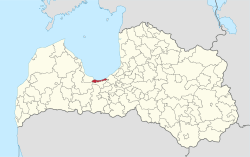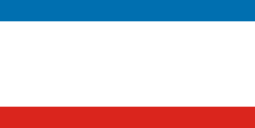Jūrmala
| Jūrmala | |||
|---|---|---|---|
| City | |||
| |||
 Location of Jūrmala within Latvia | |||
| Coordinates: 56°58′N 23°45′E / 56.967°N 23.750°ECoordinates: 56°58′N 23°45′E / 56.967°N 23.750°E | |||
| Country |
| ||
| Town rights | 1959 | ||
| Government | |||
| • Mayor | Gatis Truksnis | ||
| Area | |||
| • Total | 100 km2 (40 sq mi) | ||
| Population | |||
| • Total | 56 060 | ||
| • Density | 560/km2 (1,500/sq mi) | ||
| Time zone | EET (UTC+2) | ||
| • Summer (DST) | EEST (UTC+3) | ||
| Postal code | LV-2003; LV-2008; LV-20(10-17) | ||
| Calling code | +371 67 | ||
| Number of city council members | 15 | ||
Jūrmala (Latvian pronunciation: [juːrmala] "seaside"; German: Riga-Strand, Baltische Riviera[1]) is a city in Latvia, about 25 kilometres (16 miles) west of Riga. Jūrmala is a resort town stretching 32 km (20 miles) and sandwiched between the Gulf of Riga and the Lielupe River. It has a 33 km (21 miles) stretch of white-sand beach, and a population of 55,580, making it the fifth largest city in Latvia.
While Latvia was part of the Soviet Union, Jūrmala was a favorite holiday-resort and tourist destination for high-level Communist Party officials, particularly Leonid Brezhnev and Nikita Khrushchev. Although it has many amenities such as beach-houses and concrete hotels remain, some have fallen into disrepair. Jūrmala remains a tourist attraction with long beaches facing the Gulf of Riga and romantic wooden houses in the Art Nouveau style.
In publications dating from the Soviet period, the city name was occasionally spelled in English as Yurmala, a back-transliteration from Russian.
History
_house.jpg)

The city of Jūrmala actually consists of a string of small resorts. From west to east, these include Ķemeri, Jaunķemeri, Sloka, Kauguri, Vaivari, Asari, Melluži, Pumpuri, Jaundubulti, Dubulti, Majori, Dzintari, Bulduri and Lielupe.
The area now comprising the city of Jūrmala was formerly part of Riga, known as Rīgas Jūrmala. Some parts of the area, like Sloka and Ķemeri, have been known as health resorts for centuries. Jūrmala was once known in German as Riga-Strand, or "Beach of Riga".
Jūrmala's reputation as a spa destination began in the late 18th and early 19th centuries. Wealthy landowners began the tradition of relaxing at the seaside, and Russian army officers came here to rest after the Napoleonic Wars, returning later with their families. The peak of the Jūrmala area's development was the opening of the Riga - Tukums railway in 1877 (which still passes through Jūrmala) that gave a great boost to the numbers of visitors, and thus a boost to the development of the town as a resort. Jūrmala also gained a reputation as a health spa. The sea breeze, pine aroma, mineral springs, and sandy beach encouraged many sanatoriums to develop within the city.
In Soviet times Jūrmala was popular with the Communist officials because of its beach and sanatoriums - holidays were also given as rewards for top union members. It became one of the most popular holiday destinations in the whole Union. The spas offered facilities from mud baths to riding therapy and hiking in the woods. In summer there are many concerts.
Jūrmala gained official status as a city in 1959. The railway line became electrified and today it features the most regular train service in Latvia.
Whereas Riga has advanced rapidly to embrace and cater for growing numbers of Western tourists, Jūrmala has lagged behind. Russians are now subject to strict visa requirements and its beaches have yet to attract significant numbers of Europeans, leaving the tourist industry with a hard task on its hands. However, during the past few years, Jūrmala has started to recover. Many Russian celebrities, successful businessmen and others have been buying houses near the beach, and lots of different festivals and other activities have brought more and more people to the town each summer. At the moment, Jūrmala has almost achieved the popularity that it experienced by the Soviet elite.
The main beach at Majori and another at Bulduri now bear blue eco-flags signalling the sea is clean and safe to swim in, and the Latvian Academy of Science boasts a hotel for its members in the town. There is also the Midsummer Festival in June, celebrating the longest day of the year. The 'Jaunais Vilnis' New Wave (competition) music festival showcases the latest music from all over Europe. The Lonely Planet guide to the region states that it is one of the highlights of Latvia.[2]
Architecture
The most distinguishing architectural feature in Jūrmala is the prevalence of wooden houses dating from the 19th and first half of the 20th century. Most of the buildings were built by Baltic German and Latvian architects, but there also are works of Russian, Finnish and other architects. Jūrmala's architecture typically falls into classicism, national romanticism, and modern styles. The town has an official list of 414 historical buildings under protection, as well as over 4,000 wooden structures.. The Dubulti Station is an example of sculptural concrete shell Modernist architecture.
Beach
Jūrmala's beach is 33 km (21 mi) long, covered with white quartz sand. The shallow coastal waters are suitable and safe for children. The beach is equipped with playgrounds, small benches, football fields and volleyball courts, as well as descents for prams and wheelchairs. In Spring and Autumn amber pieces can be found on the beach.
Each region's beach has its own character. In Majori and Bulduri, where the Blue Flag flies, it is possible to rent water bicycles or relax in the beach cafe. In Dubulti and Dzintari competitions in beach football and volleyball take place, but on Pumpuri beach there is kite surfing and windsurfing.
International water sports contests, including rowing, sailing, and waterskiing that take place on the river Lielupe. In January 2012, Jūrmala hosted the 2012 Winter Swimming World Championships.

Demographics
As of 1 January 2011, the city had a population of 56,060.
Mayor
- Raimonds Munkevics (?-2010)
- Romualds Ražuks (2010)
- Gatis Truksnis (I.term) (2010-2013)
- Juris Visockis (2013)
- Gatis Truksnis (II.term)(2013-2016)
- Rita Sproģe (acting)(2016)
- Gatis Truksnis (III.term)(2016-present)
Personalities
The following people were born in Jūrmala:
- Imants Ziedonis (1933-2013), poet
- Ernests Gulbis (born 1988), tennis player
Festivals
During the Soviet era, Jūrmala was a venue for various festivals, including the pop music festival "Jūrmala" (1986–1993).[4]
Since 2001 Jūrmala had hosted a competition for young pop singers, "New Wave", from all over Europe. It also hosted the "Singing KiViN" event each July. Due to the ban on Russian media personalities entering Latvia, both competitions were moved from Jūrmala.[5][6]
The Jūrmala International Piano Competition, arranged by the City Council and the Latvian Piano Teachers Association in collaboration with the Ministry of Culture of Latvia, for pianists of all nationalities aged 19 years and under, was established in 1994 and is held every two years in the "Dzintari" concert hall. As the International Academic Music Competition (with various categories), it reached its 11th Season in 2010.[7]
Twin towns - sister cities
 Anadia, Portugal
Anadia, Portugal Eskilstuna, Sweden
Eskilstuna, Sweden Jakobstad, Finland
Jakobstad, Finland Gävle, Sweden
Gävle, Sweden Cabourg, France
Cabourg, France Palanga, Lithuania
Palanga, Lithuania Pärnu, Estonia
Pärnu, Estonia Kazan, Russia
Kazan, Russia Terracina, Italy
Terracina, Italy Türkmenbaşy, Turkmenistan
Türkmenbaşy, Turkmenistan Alushta, Crimea
Alushta, Crimea
References
- Notes
- ↑ Der Rigasche Strand - Baltische Riviera: illustrierter Führer durch Die Badeorte des Rigaschen Strandes. - Herausg. - [Riga] : Kulturverein des Rigaschen Strandes, [1928?]
- ↑ "Jurmala is its architecture of the 19th century and a half of the 20th century". riga-guide. Retrieved 8 July 2016.
- ↑
- ↑ About Jurmala pop music festival Archived August 23, 2008, at the Wayback Machine.
- ↑ Фестиваль "Новая волна" переедет из Юрмалы в Сочи [The festival "New Wave" will move from Jurmala to Sochi]. Interfax. 12 January 2015. Retrieved 31 January 2015.
- ↑ КВН и "Юрмалина" отказались от выступлений в Юрмале. Interfax. 13 January 2015. Retrieved 31 January 2015.
- ↑ See The 7th International Festival Archived July 17, 2011, at the Wayback Machine., and also 11th International Academic Music Competition "Jūrmala 2010", May 16-23, 2010.
- ↑ "Sadraudzības pilsētas". jurmala.lv. Retrieved 26 April 2014. (Latvian) (English)
External links
| Wikivoyage has a travel guide for Jūrmala. |
| Wikimedia Commons has media related to Jūrmala. |
Photos and videos
- 360° QTVR fullscreen panoramas of the Jurmala city
- Images from Jurmala
- Panorama of Jurmala (WebCam), balticlivecam.com


